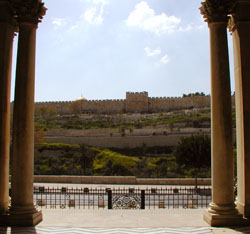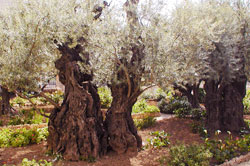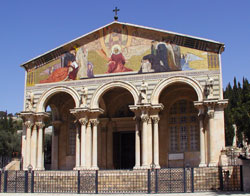| March
2009 - Vol. 28

Agony in the Garden of Gethsemane,
by El Greco 1541-1614
The
Agony in the Garden: Love’s Surrender
by Jeanne Kun
After the Last
Supper, Jesus withdrew with his disciples to the Mount of Olives to pray,
knowing that in a few hours his mission and God’s plan of salvation would
be fulfilled by his passion and death. Previously Peter, James, and John
had been privileged to witness Jesus’ glory at his transfiguration (see
Matthew 17:1-18; Mark 9:2-13; Luke 9:28-36), perhaps to strengthen their
faith so that they would be prepared to now witness his harrowing anguish
in Gethsemane. But like Job’s three friends, Eliphaz, Bildad, and Zophar,
who provided little comfort for Job because they couldn’t grasp the “why”
of his suffering, Peter and the sons of Zebedee gave Jesus no consolation
during his hours of agony. Rather, they fell asleep as they had done before
on the mount of the transfiguration, this time overcome and fatigued by
their grief (see Luke 9:32; 22:45).
Jesus had urged
his companions to stay awake and pray not to come into the time of trial
(see Mark 14:38a), yet they failed to be vigilant—and thus they later lacked
strength when tested and fled. Scripture scholar George Montague
notes that when Jesus addressed the drowsy Peter, he used the apostle’s
name [Simon], evoking his human weakness.” Jesus was saddened by his friends’
failure but not surprised. Sharing in our humanness, he understood the
weakness of the flesh even when the spirit is willing (see 14:38b).
Jesus’ experience
in Gethsemane was a critical point in his determination to hold fast to
his call. In ancient times, the Greek word agonia was a technical
term used to describe the sweat athletes produced as they did “warm-up”
exercises to loosen up and ready their muscles for competing in the Olympic
games. Seen in this light, Jesus’ agony in the garden was a warm-up for
his coming passion and crucifixion.
A costly battle
When, at the
outset of this public ministry, Jesus had resisted Satan’s attempts to
deter him from his mission, the devil had “departed from him until an opportune
time” (Luke 4:13). Now Jesus entered into a battle that would ultimately
deliver all humankind from the power of Satan. It would be a costly battle.
Jesus would have to bear not only physical tortures and suffering but also
“our sins in his body on the cross” (1 Peter 2:24). He would experience
in his humanity a sense of abandonment by the Father (see Matthew 72:46).
So great was this battle that, Luke the physician tells us, bloody sweat
fell from him as he prayed. Yet, he had not been abandoned by his Father.
Just as Jesus had been ministered to by angels after his encounter with
Satan in the wilderness, an angel came to strengthen him (see Luke 22:43-44;
Matthew 4:11; Mark 1:13).
Jesus wrestled
with the human dread of his impending torments, yet he submitted to the
Father’s will without any word of mistrust or rebellion: “Abba, Father,
for you all things are possible; remove this cup from me; yet, not what
I want, but what you want” (Mark 14:36). As Benedictine Sister Maria Boulding
notes,
Gethsemane
was the death-struggle between all that was less than his vocation, yet
still had power to attract him, and the purer, freer will in him that could
be content with nothing less than abandonment to the utter mysteriousness
of the Father’s love. He died in this abandonment, believing in the love
of the Father who delivered him to death and seemed to be silent. His act
of surrender as he said, “Father, into thy hands I commit my spirit” was
the breakthrough, the leap beyond all limitations; such obedient love could
be vindicated only on the other side of death. St. Paul says that Christ
was obedient unto death, but this inevitably meant obedient unto life:
the unlimited life, love, freedom and joy of his resurrection. (Prayer:
Our Journey Home)
Jesus won through
those fearsome hours in Gethsemane, clinging to his knowledge of the Father’s
love for him and for all humankind. Readied by his firm acceptance of God’s
will, he went forward with peaceful dignity to receive Judas’ traitorous
kiss and meet his captors (see Mark 14:42-46).
Grow!
1.
When have you been tempted, like Peter, James, and John, to “fall asleep,”
turning a blind eye to someone who is in distress or struggling to follow
God’s will? What attitudes (such as complacency, reluctance to get involved,
feelings of inadequacy) might have held you back? What would help you to
be more open to offering support in the future?
2.
Recall a time when it required great effort for you to accept God’s will.
Why was acceptance difficult for you? Fear of what God was asking of you?
Reluctance to give up your own desires or plans? What was your prayer like
then? What did you learn about yourself through this experience?
3.
Do you address God as “Abba, Father” (Mark 14:36) as freely—and as honestly—as
Jesus did? What have you learned from the way Jesus prayed in Gethsemane?
4.
To what specific area of your life do Jesus’ words “the spirit indeed is
willing but the flesh is weak” (Mark 14:38) apply right now? What impact
does knowing that Jesus understands your weakness have on you? Recast Jesus’
prayer in Gethsemane in your own words to help you surrender this area
to God.
5.
What are some dangers to your spiritual wellbeing and relationship with
the Lord that you should be vigilant against? How might Jesus’ admonition
“Keep awake and pray that you may not come into the time of trial” (Mark
14:38)” help you?
Jeanne Kun is a noted author
and a senior womens' leader in the Word
of Life Community, Ann Arbor, Michigan, USA.
Excerpt
from Jesus’
Journey to the Cross: A Love unto Death (The Word Among Us Press,
2008). Copyright © 2008 Jeanne Kun. All rights reserved. Used with
permission.
This
book can be ordered
online at www.wau.org.
|
The
Scene
Mark
14:32-42
32
They went to a place called Gethsemane; and he said to his disciples, “Sit
here while I pray.” 33He took with him Peter and James and John, and began
to be distressed and agitated. 34And he said to them, “I am deeply grieved,
even to death; remain here, and keep awake.” 35And going a little farther,
he threw himself on the ground and prayed that, if it were possible, the
hour might pass from him. 36He said, “Abba, Father, for you all things
are possible; remove this cup from me; yet, not what I want, but what you
want.” 37He came and found them sleeping; and he said to Peter, “Simon,
are you asleep? Could you not keep awake one hour? 38Keep awake and pray
that you may not come into the time of trial; the spirit indeed is willing,
but the flesh is weak.” 39And again he went away and prayed, saying the
same words. 40And once more he came and found them sleeping, for their
eyes were very heavy; and they did not know what to say to him. 41He came
a third time and said to them, “Are you still sleeping and taking your
rest? Enough! The hour has come; the Son of Man is betrayed into the hands
of sinners. 42Get up, let us be going. See, my betrayer is at hand.”
(See
also Matthew 26:36-46; Luke 22:39-46)

View from
Gethsemane - looking towards the Temple Mount in Jerusalem, photo by Dick
LaCroix
In
the Spotlight
The
Garden of Gethsemane
The
garden of Gethsemane lies east of Jerusalem, beyond the Kidron Valley and
at the foot of the Mount of Olives. The name “Gethsemane” is derived from
the Hebrew, Gat-shemanin, meaning “oil press.” Most likely, a press
for extracting oil from olives was located in what may have been the garden
of a private estate. Jesus and his apostles occasionally used the site
as a place of retreat (see John 18:2). Nearby is a small cave, traditionally
called the Grotto of Betrayal, where the disciples could have been resting
when Judas led the band of Roman soldiers to Gethsemane to arrest Jesus.
Scripture
scholars speculate that Gethsemane may have been owned by the family of
Mark. The young man wearing a linen cloth who fled at Jesus’ arrest was
possibly the evangelist’s subtle reference to himself (see Mark 14:51-52),
and his nighttime presence in the garden would be logically accounted for
if the property belonged to his family.

7th century
Olive trees at Gethsemane
On
the traditional site, visited by millions of pilgrims over the centuries,
are olive trees that are estimated to date from the seventh century. The
Jewish historian Josephus Flavius noted the destruction of the olive trees
on the Mount of Olives by the Roman army of Titus during the siege of Jerusalem
in AD 68-70. Today the grove of olive trees is enclosed by a stone wall
and cared for by the Franciscans.

Church
of the Nations, photo by Dick LaCroix
Next
to the garden is the Church of the Nations, built in the early twentieth
century over the ruins of Byzantine and crusader churches. Within it is
preserved the traditional “Rock of Agony,” recalling Jesus’ anguished prayer.
The
garden of Gethsemane where Jesus, the “New Adam,” prevailed over temptation
and embraced God’s will, stands in contrast to the garden of Eden where
Adam and Eve were tempted by Satan and disobeyed God.
|